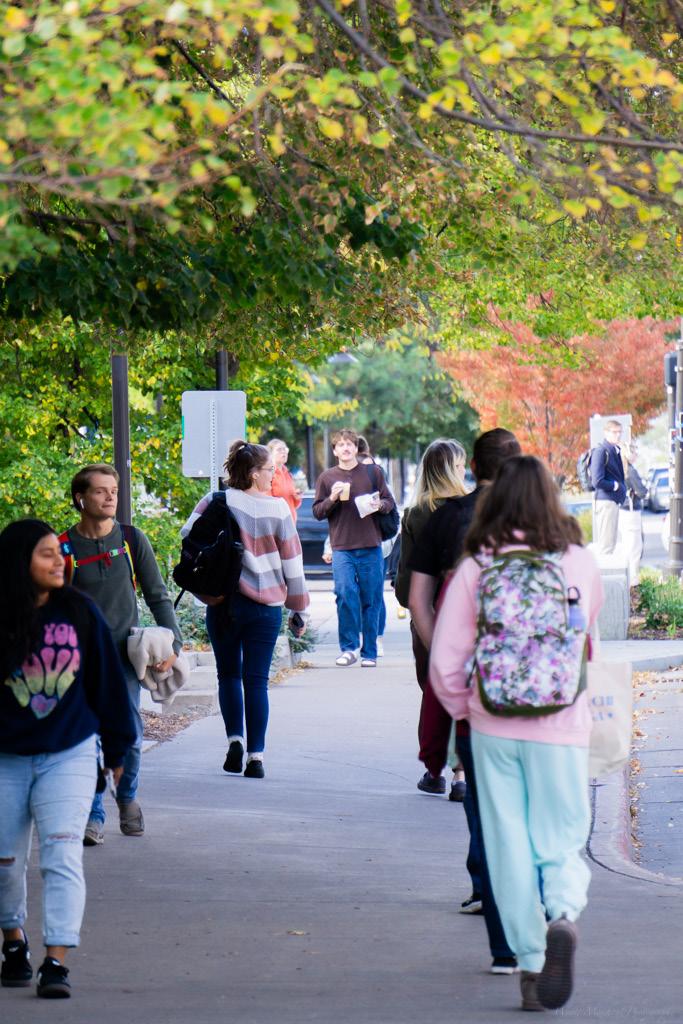
5 minute read
Going CAR-FREE IN LOGAN:
by Emma Shelite
Logan may not be known for towering skyscrapers or massive subways, but for many Utah State University students, it offers something more important: a livable, walkable city experience — even without a car.
As housing prices and gas costs rise nationwide, more college students are asking whether they can cut transportation expenses by ditching the car altogether. According to some Aggies, the answer in Logan is a confident yes.
Students like Sarah Allen and Shae Rasmussen have spent years navigating Logan without personal vehicles, relying instead on the Cache Valley Transit District, or CVTD, bus system, walkable streets, carpooling and creative planning to get around. Their stories offer a window into what car-free life looks like in a town built more around crosswalks and shuttle loops than rush hour traffic.
“I use the CVTD buses almost every day,” Allen, who has attended Utah State since 2022, said. “The drivers are friendly, the stops are clearly marked and the timing is usually spot on. I always felt like I could rely on the system to get to work and class.”
CVTD buses operate Monday through Saturday across Logan and surrounding towns. Most routes, including the popular Blue and Green Loops, connect key areas like USU, downtown Main Street, grocery stores and residential neighborhoods. For students, the system has become an alternative lifeline.
“Honestly, I wish more people used it,” Rasmussen said. “People don’t always realize that it’s free, it runs six days a week and it really does get you where you need to go. You just have to plan a little.”
Planning is part of the trade-off. Without a personal vehicle, errands can’t always happen on the fly. Students report that time management, flexibility and communication with roommates or friends are key to making the lifestyle work.
“I’ve had to schedule my appointments around bus times or ask a friend if I could ride with them,” Rasmussen said. “Sometimes I even walk home from appointments because I don’t have a ride back, but it’s always manageable.”
For many, grocery shopping and social plans are among the biggest challenges. Getting to class or work may be easy with a bus route — especially with the Aggie Shuttle, which has multiple buses running students around campus during the school year — but grabbing a late-night bite or hauling a week’s worth of groceries home is another story.
“If I want to go somewhere the bus doesn’t quite reach, I find the closest stop and walk the rest of the way, and carpooling helps so much,” Allen said.
Some businesses and locations, like Costco or certain restaurants outside the core transit areas, remain difficult to access.
“If you’re picking up food to go, by the time you walk it home, it’s already cold,” Rasmussen said.
Despite those hiccups, both students emphasized how much they’ve gained by not driving.
“Going car-free helped me get to know Logan better,” Allen said. “I was walking around campus more, figuring out side streets and cut-throughs and just paying more attention to my surroundings. I felt more connected to where I live.”
Rasmussen echoed that point, saying the lifestyle has changed her view of city design altogether.
“I never thought about city planning before college, but now I do,” Rasmussen said. “I wish more places were like Logan: walkable, small and safe. I think we should be advocating for more public transit, especially for people who can’t afford a car.”
Safety, they both said, hasn’t been a major concern. While some neighborhoods off Main Street lack lighting at night, neither reported feeling unsafe during their commutes.
“I’ve walked home in the evening a lot and never had an issue,” Allen said. “Logan feels like a really safe town to get around in, even without a car.”
Technology plays a big role in keeping things running smoothly. Both students mentioned apps that help them track buses and manage their schedules. Google Maps is a favorite for timing trips, while CVTD’s official app and the Passio GO! app used by the university provide live updates on Aggie Shuttle locations.
“I always check the app before I leave,” Rasmussen said. “Sometimes the bus shows up a little early, so I make sure I’m there five or ten minutes ahead.”
For those considering going car-free in Logan, Allen and Rasmussen offered similar advice: live near campus or central routes, get to know the bus system early and don’t be afraid to ask for help.
“Google Maps will be your best friend,” Allen said. “And always plan to take the slightly earlier bus in case something runs behind. But honestly, the system is more reliable than people expect.”
Rasmussen said lifestyle also plays a role.
“If you’re someone who doesn’t mind walking and you’re strategic about where you live, it’s totally doable,” she said. “Just know that it takes a little more effort and coordination, but you can save so much money and stress.”
Some parts of town feel like they were made with pedestrians in mind, particularly campus and downtown.
“I’ve walked to so many places on Main Street,” Allen said. “It’s fun, it’s walkable and the bus stops are right there.”
For those who rely on cars daily, the idea of ditching one might sound impossible, but students like Allen and Rasmussen say their experiences in Logan prove otherwise.










